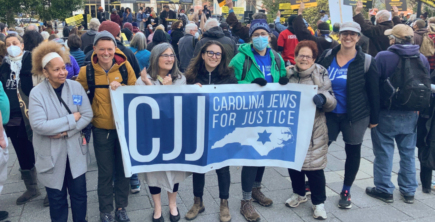
Healthy Individuals & Communities


Decades after the term “digital divide” was coined, this systemic inequity persists, preventing too many people from living a quality life—and sometimes even to survive. In the past two years, the COVID-19 pandemic has exacerbated the gulf between those with internet access and those without, as necessary activities like seeking healthcare, education, and jobs have moved online.
For our Corporate Impact Leaders Forum (CILF) series, Strategies to Bridge the Digital Divide, Tides recently brought together four panelists, experts in the subject of equity and the digital divide, to identify challenges and solutions. Led by Amy Lesnick, chief executive and president of Pledge 1%, the panel included Jen Stredler, vice president of workforce development at Salesforce; Ellen McClain, COO of Year Up; and Caroline Barlerin, founder and CEO of Platypus Advisors.
Lesnick opened the discussion with sobering statistics that paint a grim picture: 43 percent of adults with lower incomes do not have access to home broadband and 41 percent don’t have access to a desktop or laptop. Nearly half of Americans without home internet are either Black or Hispanic. And while the Biden administration allocated more than $65 billion to broadband through the Infrastructure Investment and Jobs Act, broadband alone is but one small piece of the digital divide.
“It’s an enormous challenge, especially for vulnerable populations,” Lesnick said. “In many cases, the digital divide is not only a result of historical inequities, but also perpetuates them. And COVID-19 has only highlighted and in many cases exacerbated these inequities.”
Stredler, vice president of workforce development at Salesforce, acknowledged the enormity of the issue. “The problem and the scope of the challenge is vast,” she said, noting that the many factors causing this divide must be tackled by leveraging the unique roles and assets that different companies can bring. “We can’t all do everything and we can’t all do it alone.”

43% of adults with lower incomes do not have access to home broadband and 41% don’t have access to a desktop or laptop. (Photo © Mimi Thian)
Ellen McClain, COO of Year Up, focused on the root issue during the panel discussion. “The digital divide is deeply, deeply rooted in the systemic issues, including systemic racism, that have plagued our nation from its inception,” she said. McClain identified the global response to George Floyd’s murder as a catalyst, pointing to the “fundamental systemic unfairness” that continues to wreak havoc in our country.
In the face of a challenge so complex and embedded, what can companies do? A lot, according to McClain. “We operate with a fundamental belief that corporations can and do play a role in advancing equity and justice and the conditions for our communities and economy to thrive,” she said of her team at Year Up.
All panelists agreed that collaborative efforts are crucial in the face of these challenges. As Stredler pointed out, it’s “not sustainable for every company to support every need of every person. But,” she went on, pointing to the importance of partnership, “we’ve tried to mitigate immediate needs and then work with our partners to develop a more systemic and scalable solution.”
And while systemic and scalable solutions are absolutely essential to resolve these challenges, the need for hyperlocal solutions is also key to making progress.
Caroline Barlerin, founder and CEO of Platypus Advisors, emphasized that companies need to “coordinate locally appropriate solutions, because those that are built by community, for community, of community will stay sustainably in community.” Barlerin referred to a project she worked on in her former role as global head of philanthropy at Twitter as an example of the powerful impact of leading with listening and tailoring solutions to local needs.
Barlerin shared her experience working on the development of Twitter’s NeighborNest, located nearby the company’s San Francisco headquarters and established to support surrounding communities, which face some of the highest rates of homelessness, poverty, and drug addiction in the city and country.
“Families experiencing homelessness are needing something that many don’t consider when factoring in programs,” Barlerin stated. Place-based, human-centered design uncovered a core barrier for folks in the neighborhood that needed to be solved for: childcare. Once her team unlocked what Barlerin referred to as this “aha,” they were able to enlist the expertise of well-positioned partner organizations, including Compass Family Services, which has been serving people experiencing homelessness in San Francisco for more than 100 years, to more intentionally and effectively design NeighborNest resources and programming. Barlerin credits Twitter’s successful launch of NeighborNest as an example of the benefit of “making sure that people closest to the need are the ones closest to the solution.”
Another central issue panelists emphasized is the role workforce development plays in the digital divide. Stredler named her company’s “three-legged stool” approach to workforce development. First, they invest in grantmaking that supports workforce development organizations, which help with foundational job skills; second, they apply their values internally, seeking out and hiring untapped talent through internships, mentoring, and apprenticeship programs; and third, they engage expert partners to provide supports for building networks and social capital.

Salesforce had to contend with the need to support team members who came from underrepresented groups and communities. (Photo © Mapbox)
Stredler also spoke to the importance of acknowledging when there are challenges that require support through partnership. Salesforce found itself needing to evolve during the second half of 2020, when the nation and world were experiencing relentless attacks on Black life and mass protests in response. About the changing needs of interns and apprentices, who in many cases come from Black communities, Stredler said, “Those are needs that we can’t solve ourselves. And one of the places we realized we needed support during the last 18 months was in navigating challenges around bringing your full self to work during a racial justice crisis and reckoning, navigating trauma, and how to navigate being the only fill-in-the-blank—the only person on a team perhaps that is a person of color, the only person on a team without a degree. And we didn’t necessarily have all the skills to do that.”
McClain raised another often unrecognized and sometimes unnecessary barrier in her conversation of skills-first hiring. “We encourage folks to really consider whether your jobs need four-year degrees,” she said, “and to think deeply about the actual skills required, as opposed to the credentials.” Such consideration can shine a light on cases in which degrees are a requirement simply because degree requirements have become normalized, rather than actually being necessary for the position in question. “When you get to skills-first hiring,” McClain added, “it can become a little clearer that a broader talent pool is capable of meeting the needs.”
She went on to provide a powerful example from her own company, where a third of the finance office is successfully run by Year Up graduates. “Had we not been thinking about it,” she said, “we would just say, ‘Oh, yeah, you need a four-year degree to do this.’ And the reality is, you don’t. Once you cross that threshold, it opens up that potential.” She clarified that the inverse is also true: “If you insist on a four-year degree, it closes off opportunity to a whole lot of Black and brown people.”
Among all of the powerful examples shared by panelists, the underlying acknowledgment is that this work is nowhere near done.
“It is always going to change,” Stredler said, emphasizing that “we will just need to continue to build the muscle of adaptability.” Alongside the importance of flexibility, solving for the digital divide requires critical thinking and collaboration.
Barlerin honed in on these elements of the work, saying, “We need to think about and cover the various dimensions of this, and it has to be a team sport. We need to go at it collectively to really tackle and solve what I think is the essential human right of internet connectivity.”
McClain closed out with a powerful reflection bringing it back to the root of the problem, as she did in the conversation’s opening. “Perhaps we can together get to the heart of the matter,” she said, “when we can begin to create cultures of belonging within our corporations that are multiracial, multiethnic, and where people have a sense that they are respected because they are seen and heard, for all aspects of their identity. I think when we unlock that,” she concluded, “we can really unlock all kinds of solutions for the things that plague us.”

Healthy Individuals & Communities

Our Community

Philanthropy

Read the stories and hear the voices of social change leaders fighting for justice.